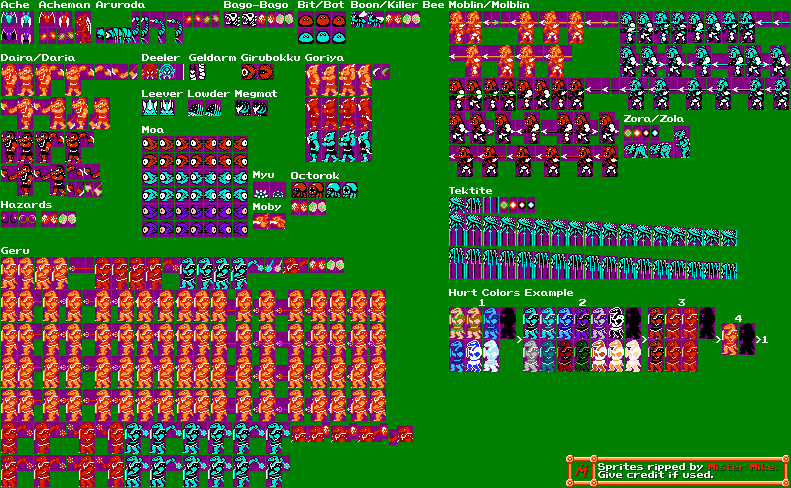Overworld Enemies
(Current scale is below 100% - zoom in to view full detail)


| Asset Info favorite | |
|---|---|
| Name | Overworld Enemies |
| Category | NES |
| Game | Zelda 2: The Adventure of Link |
| Section | Enemies & Bosses |
| Submitted | August 9, 2019 |
| Uploaded By | MisterMike |
| Size | 59.41 KB (791x488) |
| Format | PNG (image/png) |
| Hits | 24,156 |
| Tags (13): arrow_right | |
Animated GIFs (0)
Comments (2)
You must be logged in to post comments.
What's with the effed-up looking Moas?
Anyways, I can't thank you enough for this. Especially for making the key there so people who don't have good knowledge on the palette system (unlike you or I) can understand it properly.
I do question, however, why the village red palette seems to be on the lower level as the alt for the overworld red, while the village "blue" is on the upper one.
Anyways, I can't thank you enough for this. Especially for making the key there so people who don't have good knowledge on the palette system (unlike you or I) can understand it properly.
I do question, however, why the village red palette seems to be on the lower level as the alt for the overworld red, while the village "blue" is on the upper one.
Thanks man. Nice to see you like it.
Anyways, the "messed up" frames Moas have is actually their turning animation. The way this works is that the game pulls both of it's 8x16 sprites together for the first three frames, flips them, swaps them between eachother, and pushes it's sprites back to normal for the latter three frames. This gives the illusion of the Moa gently turning itself around. What's more, this doesn't require any additional sprites to do so, which saves on VRAM space. This same effect is used for Rebonack while he's on his horse. The only issue with the Moa's turning, and flaw that Rebonack lacks, is that the leftmost sprite is always layered over top of the rightmost sprite. This makes it so that when it's facing to the right, it's torso sprite is layered over it's face sprite, which I believe wasn't supposed to happen. Granted, it's barely noticeable during gameplay.
Regarding the palettes, it's actually quite simple. The NES uses 4 sets of four colors: One for the background layer, and one for the sprite layer. The colors for each set changes whenever a new color is needed. I tried to organize these colors based on which ones are the most common, which is why the villager's red palettes are below the normal red palettes. The Villager's blue is in the upper row is simply for organization's sake.